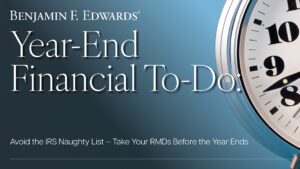By Theresa Cagle Fry, Senior Vice President and Manager IRAs, Retirement & Education Planning
![]() Print This Post
Print This Post

As the holiday season approaches and calendars fill with celebrations, it’s easy to overlook important financial deadlines. But before the year ends, reviewing your retirement accounts should be on your checklist–right alongside wrapping gifts and booking travel. Two key actions to consider before December 31 include taking your Required Minimum Distributions (RMDs) and making Qualified Charitable Distributions (QCDs). These steps not only help you ensure that you are meeting IRS requirements but can also support your tax and giving goals as the year wraps up.
Saving in an IRA or workplace retirement plan, like a 401(k), is a great way to prepare for retirement. However, the up-front tax benefits and tax deferral as your savings grow come with a tradeoff. You must take annual RMDs once you reach a certain age. RMDs can also apply at any age if you inherit a retirement account from someone. Missing your RMD deadline can result in IRS penalties, and overlooking QCDs could mean missing a valuable opportunity to reduce taxable income.
RMDs Generally Start at Age 73, But Exceptions Apply
For Traditional IRAs, SEPs and SIMPLE IRAs, RMDs now begin at age 73. For workplace retirement plans, such as a 401(k), 403(b) or 457(b):
- RMDs don’t usually have to begin If you are still working for the employer that provides the retirement plan. They begin once you separate from service or retire if you are 73 or older.
- However, if you own 5% or more of the business, or if you are no longer working for the employer offering the retirement plan, you’ll need to make sure you take your RMD for 2025 from the plan if you are 73 or older.
RMDs can be taken at any time during the year, but generally no later than December 31. If this is your first RMD year, an exception applies. You have the option to delay taking your RMD, but not any later than April 1. If you elect to delay your first RMD, keep in mind that you will have to take two RMDs next year. For example, if you turn 73 this year, you can delay taking your 2025 RMD until April 1, 2026–but you’ll also need to take your 2026 RMD by December 31, 2026.
RMDs for Inherited Retirement Accounts Apply, Regardless of Age
If you inherited a retirement account, you also must take RMDs, although the rules that apply are more complicated. If the account owner died in 2020 or later:
- Annual RMDs must begin in the year following the account owner’s death if you are an “eligible designated beneficiary”:
- Surviving spouse
- Disabled or chronically ill
- Not more than 10 years younger than the account owner
- Minor child of the account owner (until the age of majority)
- The 10-year rule applies to all other non-spouse beneficiaries:
- You must take annual RMDs if, at the time of the account owner’s death, they were taking RMDs. You also must distribute the entire remaining account balance by the end of year 10.
- You are NOT required to take annual RMDs if the account owner died before their RMDs began or if the inherited account is a Roth IRA. You must still distribute, however, the entire remaining balance by the end of year 10.
QCDs: A Tax-Smart Way to Give
A QCD is a direct tax-free gift from your Traditional IRA to a qualified charity.[1] QCDs do not increase your taxable income. Therefore, they do not increase your adjusted gross income and can be a tax-efficient strategy even if you do not itemize. Although you cannot make a QCD from a workplace retirement plan, such as a 401(k), SEP IRA or SIMPLE IRA, QCDs can be made by IRA owners or beneficiaries of inherited IRAs if age 70 ½ or older.
|
QCD Limits and Eligibility |
|
| QCD Limit for 2025 | Up to $108,000 |
| Eligibility Age | Must be 70 ½ or older |
| Eligible Accounts | Traditional IRAs only |
| Deadline | Gift Completed by December 31, 2025 |
A QCD is not limited to your RMD. You can do a QCD before RMDs begin if you are at least age 70 ½. And your QCD can be up to $108,000, even if your RMD is less than that amount.
Year-End Is Quickly Approaching
Whether it’s meeting your RMD obligations or making a tax-smart charitable gift through a QCD, these decisions can have a meaningful impact on your retirement strategy. Don’t wait–connect with your financial advisor today to ensure your plan is taken care of before December 31.
IMPORTANT DISCLOSURES: The information provided is based on internal and external sources that are considered reliable; however, the accuracy of this information is not guaranteed. This piece is intended to provide accurate information regarding the subject matter discussed. It is made available with the understanding that Benjamin F. Edwards is not engaged in rendering legal, accounting or tax preparation services. Specific questions on taxes or legal matters as they relate to your individual situation should be directed to your tax or legal professional.
______________________________________
[1] In addition to direct gifts to a public charity, a one-time gift of up to $54,000 can be made from an IRA to a split-interest entity, such as a charitable gift annuity, charitable remainder unitrust or charitable remainder annuity trust. Talk with your legal or tax professional about the requirements if this is of interest to you.